This article was written for an appeared in the Ojai Valley News on June 11, 1999. It is reprinted here with their permission.
Orchid Town was an attraction in the ’40s and ’50s
by David Mason
“Gardening is one of the best things in the world to make you forget your troubles, so as you go along, take a little time out and relax in your garden amongst the flowers.”
— Louis Boyle, Out West, 1952
The lavish two-story hotel with its sweeping veranda would have no overnight guests. The post office has not postmaster, the Orchid Café couldn’t serve a decent cup of coffee and there were no children learning their ABC’s at the Deer Little School.
The blacksmith shop was silent and no hymns were heard coming from the Community Church. The Last Chance Saloon never served liquor; the jail never held a prisoner; and the justice of the peace? Well, he never married a single couple.
This may sound like a very dull town, but on the contrary, it was probably one of the most exciting old beautiful towns in all of Southern California.
El Rancho Rinconada, Orchid Town, was the dream of a wealthy man.
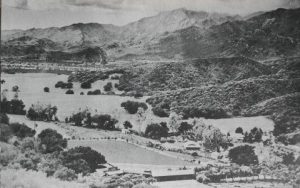
When Louis Boyle purchased the 77-acre ranch in the Ojai Valley in March of 1939, it consisted of a small house, garage and barn. Within a year, the land would start to spring forth with an array of exotic plants, for Mr. Boyle’s dream was to develop his ranch into a paradise of flowers.
Mr. Boyle was not raised in the flower business. His father had come to California with his family in the 1890s and had obtained employment in the iron and steel business, which he did quite successfully. His company manufactured barrels, canteens, camp stoves, tin cans and garbage cans.
The elder Boyle eventually took over the Pacific Stove Company, which made heaters and stoves; one popular line of heaters sold for 90 cents each.
One employee was an ambitious man by the name of Parkie O’ Keefe, the plant superintendent and salesman, who would sell stoves, write up the orders, come back to the plant, change clothes and work to make the stoves.
In 1913, Bob Merritt came to work for the Pacific Stove Company. After a few years, Mr. Merritt, longing to go into business for himself, convinced Mr. O’ Keefe to join him. The elder Boyle sold the stove manufacturing end of his business to them and retained a financial interest in their business, which came to be known as O’ Keefe and Merritt.
The Boyle manufacturing company was sold to the United States Steel Company in 1939 and it was then that Louis Boyle came to the Ojai Valley and bought El Rancho Rinconada.
He was not the first man to see the possibilities in this secluded ranch in the little valley. The previous owner, Loring Farnum, had attended Thacher School from 1898 until 1900 and was so impressed with the Ojai Valley that in 1908 he purchased the ranch and named it El Ranch Rinconada. He built a white farm house, planted a prune orchard and raised horses.
The original Farnum house was one of the 60 buildings in the valley that was lost in the great 1917 fire. Mr. Farnum was on the Boyd Club Board of Trustees and he was the first person to introduce radio to the Ojai Valley citizens.
Louis Boyle was enthusiastic about creating a sprawling ranch of orchids and other unique plans. He had attended the 1938 Pasadena Flower Show, where a large display of cymbidium orchids had caught his eye.
The Orchid Ranch would have to be unique, the land encircled by the mountains was too magnificent to construct just ordinary rows of lath and greenhouses.
The idea of creating a western town as a front for the flower beds was decided upon as an attractive way to conceal the lath house structures. Mr. Boyle and his helpers spent months going through junk yards, picking up old doors, windows and lumber.
The first building was the hotel. The imposing structure would stand out from the rest of the town. The windows were actually shadow boxes that held a variety of treasures. Each window box told a different story of the history of the Old West. They included old guns, powder horns, lamps and spectacles. Some contained wooden tools, music boxes, branding irons and straight razors.
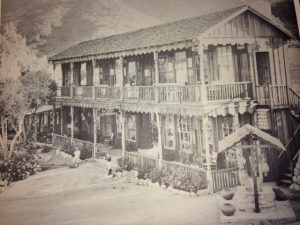
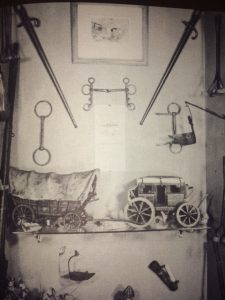
Upon entering the front door of the hotel, your first view was of hundreds of orchid plants growing in attractive gardens –- a spectacular sight.
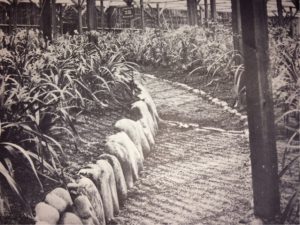
The rear side of the false front was also a treasure trove. Hung on the walls were old western pictures and newspapers. Out front stood a wishing well.
Further down the street, other false fronts continued to be built on both sides, until the town had almost all of the conveniences one would expect in a small town.
There was the drug store, church, hardware and general store. Then they had the little school, assayer’s office, the town hall and bank, the opera house and Last Chance Saloon –- and the largest building, Kate’s House, was named for one of the ladies of early San Francisco.
There was also the Chinese Laundry, King’s Harness Shop, Wells Fargo, Pony Express and The Picture Gallery.
The Picture Gallery was extraordinary. The walls were covered with beautiful pictures of orchids, the handiwork of many artists, who years ago contributed in their greatest ways to symbolizing the beautiful flowers.
The gallery consisted of more than 1,000 prints of orchids, offset in their placement on the walls to make room for the collection of museum quality antiques that were also neatly arranged in the gallery.
An office building and library were built on a low rise at the base of the mountains, so as to afford a panoramic view of the ranch. The atmosphere of the office was more like a home instead of a place of business. The library contained a large collection of rare botanical books, collected from around the world.
Over the years, the Orchid Ranch would become one of the main sources of elaborate displays at flower shows, winning many awards.
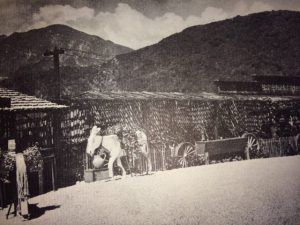
The various displays that Mr. Boyle entered in the shows were replicas of his greenhouses that were showplaces within themselves, adorned with exquisite garden statuary that added charm to the meandering rock-lined walks that encircled the beautiful beds of graceful orchids.
The camellia plants would add another source of color and beauty to the ranch. Planted throughout the property were more than 7,000 camellia bushes, consisting of 150 different varieties. Many of them were rare and unusual.
The 1948 forest fire would take its toll on the Orchid Ranch, as well as the entire Ojai Valley. At El Rancho Rinconada, lath houses burned to the ground, destroying the precious plants and flowers that the lath had been protecting. The camellias that were planted along the outskirts of the ranch, closer to the surrounding hills, were lost when the fire swept into the little valley.
The ranch was repaired of all fire damage and, in short time, was back in full operation. As though to add insult to injury, the next year it snowed on the little town. To protect the orchids, which were only covered by lath, smudge pots had to be moved in.
By 1952 there were more than 50,000 cymbidium plants growing on the ranch. Mr. Boyle learned all he could about the flowers, mostly through trial and error. His passion for cymbidiums was a major contributor to the flower’s popularity.
During the years that the ranch was in operation, the cymbidium orchid became the most popular flower for stylish corsages. Florists from around the world were supplied with the blooms shipped from El Rancho Rinconada.
There was no lovelier orchid than the cymbidium and there was no finer selection in the United States than those grown at Orchid Town, El Rancho Rinconada. Many different varieties of cymbidiums were propagated there in the many specially designed greenhouses built for the young seedlings.
The names of the cymbidiums read like a list from “Who’s Who,” including: Anne Boleyn, Bach, Mozart, Beau Brummel, Cleopatra, Godiva, Goldilocks, Hiawatha, Pocahontas, Paul Revere, Joan of Arc and Marco Polo. The royal family was not forgotten; plants were named for Queen Elizatbeth I, Queen Mary, Princess Margaret, Prince Charles and Windsor Castle. President Lincoln and President Wilson were also included in the list.
Many other unusual flowers filled the ranch greenhouses, among them the waxy red Hawaiian anthuriums and the cypripedium orchids, also known as the Slipper Orchid.
The ranch would continue to delight people from around the world, whether it be those fortunate enough to have been invited to the many private parties and official affairs that were held there, down to the excitement felt by the smallest florists across the country who received their shipments of the exquisite flowers from the ranch.
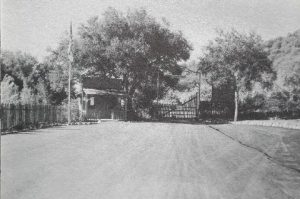
When Mr. Boyle died in August of 1954 the glory of El Rancho Rinconada began to fade, but not to the memories. I’m sure the many hours I spent as a child, admiring the quaint place and the beautiful creations of God, had a lot to do with influencing my life.
The property was eventually sold to Camp Ramah and there aren’t many of the original structures left. The office and library, the main house and guest house remain. The western town is gone and the one sign of an earlier day is the wishing well.
Camp Ramah has maintained the land with spacious lawns, tree and flowers, and the serene atmosphere remains. Today, the former El Rancho Rinconada is used for the health and enrichment of young people’s lives, not unlike what it did for the flowers many years ago.
